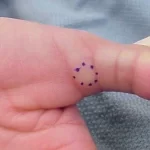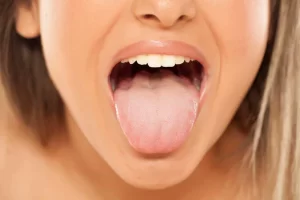If we have completed the annotation correctly over several months, we can establish a more or less regular pattern.
Before ovulation, the basal temperature usually oscillates between 36.5ºC and 36.7ºC. As a result of hormonal changes, this temperature usually increases between 0.3ºC and 0.5ºC in the two or three days after ovulation. The increase is maintained until the end of the cycle when the next menstrual period begins.
Suppose in our notes, and we observe a regular cycle (increase in temperature from the same day) for several months. In that case, we know that we will have a greater chance of becoming pregnant by having sexual intercourse from the days before that temperature change.
Ovulation: how to know if I am ovulating
This is because, in theory, we will have already ovulated, and the ovum is already ready, although the change in temperature does not indicate it, which will occur two or three days later.
In any case, the safest thing is to combine this with other methods to know what days of ovulation are, observing the menstrual cycle on the calendar and the vaginal discharge, as we said.
If we monitor cervical discharge and note changes in the same place as temperature, most women will increase temperature after ovulation and a change in the texture of the cervical mucus before and during the ovulatory period.
The fundamental thing to know about the woman’s fertile days is that we take the basal temperature properly so that the estimates are correct, for which we can follow all these tips that we have offered you.
Important things to know:
Your body's resting temperature rises slightly during the luteal phase (the second half) of your menstrual cycle.
Carefully monitoring your basal body temperature with a basal thermometer will help you know when ovulation occurred, but it will not predict when it will occur in the future.
Basal body temperature can be combined with changes in cervical discharge to determine when fertility is highest.Basal Body Temperature (BB) is your body temperature at rest, such as when you wake up in the morning. Your reproductive hormones have a measurable impact on your temperature (1,2). A BBT thermometer is more sensitive than a standard household thermometer and measures temperature more accurately.
Tracking your TB is an easy way to get an idea of when and if you are ovulating. Using it as part of the fertility observation method requires additional monitoring of symptoms, and this observation method (FAM) is not suitable for all bodies; Talk to your healthcare provider if you are interested in using a FAM for contraception.
4.8
Illustration of a five-star rating
2M + qualifications
Why Track Basal Body Temperature?
Tracking TB with Clue can help make your predictions more accurate. TB is used by Clue to assess when ovulation occurred. However, TB alone cannot predict when ovulation will occur in the future.
TB is slightly lower in the follicular phase (the first half of the menstrual cycle), and rises after ovulation, and remains elevated during the luteal phase (the second half of the menstrual cycle) (2,3). This rise in temperature occurs in response to progesterone, which is released after ovulation occurs. Progesterone prepares the uterus for the implantation of a fertilized egg. The change in temperature after ovulation is slight – BBT increases only about 0.5 ° F / 0.3 ° C to 1.0 ° F / 0.6 ° C, and can be easily affected by factors such as illness, alcohol, and changes in sleep ( 2.3).
Measuring basal temperature requires constant effort over several cycles, including:
take it immediately after waking up, while lying in bed, before sitting up or getting up,
take it every day, at the same time,
use a thermometer with an accuracy of 0.01 degrees Celsius (C) and 0.1 degrees Fahrenheit (F) to perform a precise rounding,
noting which days are "unreliable" due to environmental factors, such as changes in sleep patterns, disturbed or shortened sleep, jet lag, excessive alcohol consumption, illness or medication, which can cause changes in your menstrual cycle (2,Four. Five)Fertility Observation Methods (FAM)
Basal body temperature is one of the components of specific contraceptive methods based on s infertility awareness (FAM), called symptothermal methods. By following the rules that combine changes in TB with carefully tracked changes in cervical discharge, the most fertile days of the cycle can be estimated (that is, when someone is most likely to be treadmill).
Taking the basal temperature, the one that the body has under normal circumstances, can help to know which are the most fertile days, although by itself it is not infallible, and it should be combined with the observation of the cervical mucus to have greater certainty. The reason is that the body temperature is somewhat lower from the moment the menstruation ends until ovulation and then rises slightly around 0.2-0.5 degrees. When this elevation is maintained for three days in a row, it is the unmistakable sign that the fertile period has ended. The temperature drops again immediately before or after menstruation occurs.
Gynecologists always recommend that couples seeking pregnancy have sexual intercourse between days 7 and 20 of the menstrual cycle, although most couples focus on days 11 to 14. Keep in mind that, even if the menstrual cycle is very regular, ovulation rarely occurs with mathematical regularity since it can be anticipated or delayed, and even double ovulation occurs on successive days. Measuring your basal temperature and observing your cervical mucus will help pinpoint when your fertile days start and end.
Likewise, it is necessary to consider that the half-life of sperm is 4-5 days, while that of the ovum ranges between 12 and 24 hours, although it is easier for fertilization to occur between 4 and 6 hours after it has come off.

















Add Comment